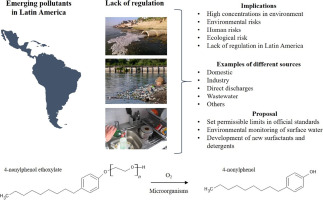当前位置:
X-MOL 学术
›
Sci. Total Environ.
›
论文详情
Our official English website, www.x-mol.net, welcomes your feedback! (Note: you will need to create a separate account there.)
Emerging pollutants (EPs) in Latin América: A critical review of under-studied EPs, case of study -Nonylphenol.
Science of the Total Environment ( IF 9.8 ) Pub Date : 2020-04-08 , DOI: 10.1016/j.scitotenv.2020.138493 Karla Vargas-Berrones 1 , Luis Bernal-Jácome 2 , Lorena Díaz de León-Martínez 1 , Rogelio Flores-Ramírez 3
Science of the Total Environment ( IF 9.8 ) Pub Date : 2020-04-08 , DOI: 10.1016/j.scitotenv.2020.138493 Karla Vargas-Berrones 1 , Luis Bernal-Jácome 2 , Lorena Díaz de León-Martínez 1 , Rogelio Flores-Ramírez 3
Affiliation

|
Emerging contaminants (EPs) represent a significant risk to human, ecological and environmental health. Although progress has been made in establishing monitoring in environmental matrices, health effects, legislation and control, there are still problems associated with regional bias and the types of EPs commonly assessed, which may underestimate the risk to health. In Latin America there are limited reports on environmental monitoring of EPs and it is generally focused on wastewater. This review identifies the current research deficiencies for emerging contaminants in the Latin American region, and we address the case of nonylphenol as an under-studied EP in the region. Nonylphenol is a degradation product of nonylphenol ethoxylate, which is a surfactant widely used in the manufacture of detergents in Latin America, environmental concentrations have been reported, predominantly in water, and the possible effects on species in this region have been also described. The importance of the review of this compound in the region lies in the fact that the Rotterdam Convention has catalogued nonylphenol as a severely restricted compound, so it is necessary to establish measures for its restriction and change to a sustainable technology. Finally, the example of NP presented in this review highlights the lack of regulation in Latin America regarding to EPs, resulting in the contamination of wastewater, effluents, rivers and drinking water. It is imperative to determine the potential effects, occurrence and concentration levels to improve the regulation of these pollutants in a timely manner.
中文翻译:

拉丁美洲的新兴污染物(EPs):对未充分研究的EPs的严格审查,研究案例为壬基酚。
新兴污染物(EPs)对人类,生态和环境健康构成重大风险。尽管在建立对环境矩阵,健康影响,立法和控制的监控方面已经取得了进展,但是仍然存在与区域偏见和通常评估的EPs类型相关的问题,这可能会低估健康风险。在拉丁美洲,关于EP的环境监测的报道很少,并且通常集中在废水上。这篇综述指出了拉丁美洲地区新兴污染物的当前研究缺陷,我们将壬基酚作为该地区被研究不足的EP来研究。壬基酚是壬基酚乙氧基化物的降解产物,壬基酚乙氧基化物是一种表面活性剂,在拉丁美洲广泛用于制造洗涤剂,已经报告了环境浓度,主要是在水中,还描述了对该区域物种的可能影响。在该地区对该化合物进行审查的重要性在于,《鹿特丹公约》已将壬基苯酚列为受到严格限制的化合物,因此有必要制定措施对其进行限制并转变为可持续技术。最后,本综述中的NP实例突显了拉丁美洲缺乏有关EP的法规,导致废水,废水,河流和饮用水受到污染。必须确定潜在的影响,发生和浓度水平,以及时改善对这些污染物的控制。还描述了对该区域物种的可能影响。在该地区对该化合物进行审查的重要性在于,《鹿特丹公约》已将壬基苯酚列为受到严格限制的化合物,因此有必要制定措施对其进行限制并转变为可持续技术。最后,本综述中的NP实例突显了拉丁美洲缺乏有关EP的法规,导致废水,废水,河流和饮用水受到污染。必须确定潜在的影响,发生和浓度水平,以及时改善对这些污染物的控制。还描述了对该区域物种的可能影响。在该地区对该化合物进行审查的重要性在于,《鹿特丹公约》已将壬基苯酚列为受到严格限制的化合物,因此有必要制定措施对其进行限制并转变为可持续技术。最后,本综述中的NP实例突显了拉丁美洲缺乏有关EP的法规,导致废水,废水,河流和饮用水受到污染。必须确定潜在的影响,发生和浓度水平,以及时改善对这些污染物的控制。在该地区对该化合物进行审查的重要性在于,《鹿特丹公约》已将壬基苯酚列为受到严格限制的化合物,因此有必要制定措施对其进行限制并转变为可持续技术。最后,本综述中的NP实例突显了拉丁美洲缺乏有关EP的法规,导致废水,废水,河流和饮用水受到污染。必须确定潜在的影响,发生和浓度水平,以及时改善对这些污染物的控制。在该地区对该化合物进行审查的重要性在于,《鹿特丹公约》将壬基苯酚列为受到严格限制的化合物,因此有必要制定措施对其进行限制并转变为可持续技术。最后,本综述中的NP实例突显了拉丁美洲缺乏有关EP的法规,导致废水,废水,河流和饮用水受到污染。必须确定潜在的影响,发生和浓度水平,以及时改善对这些污染物的控制。这篇综述中的NP实例突出了拉丁美洲缺乏有关EP的法规,从而导致了废水,废水,河流和饮用水的污染。必须确定潜在的影响,发生和浓度水平,以及时改善对这些污染物的控制。这篇综述中的NP实例突出了拉丁美洲缺乏有关EP的法规,从而导致了废水,废水,河流和饮用水的污染。必须确定潜在的影响,发生和浓度水平,以及时改善对这些污染物的控制。
更新日期:2020-04-08
中文翻译:

拉丁美洲的新兴污染物(EPs):对未充分研究的EPs的严格审查,研究案例为壬基酚。
新兴污染物(EPs)对人类,生态和环境健康构成重大风险。尽管在建立对环境矩阵,健康影响,立法和控制的监控方面已经取得了进展,但是仍然存在与区域偏见和通常评估的EPs类型相关的问题,这可能会低估健康风险。在拉丁美洲,关于EP的环境监测的报道很少,并且通常集中在废水上。这篇综述指出了拉丁美洲地区新兴污染物的当前研究缺陷,我们将壬基酚作为该地区被研究不足的EP来研究。壬基酚是壬基酚乙氧基化物的降解产物,壬基酚乙氧基化物是一种表面活性剂,在拉丁美洲广泛用于制造洗涤剂,已经报告了环境浓度,主要是在水中,还描述了对该区域物种的可能影响。在该地区对该化合物进行审查的重要性在于,《鹿特丹公约》已将壬基苯酚列为受到严格限制的化合物,因此有必要制定措施对其进行限制并转变为可持续技术。最后,本综述中的NP实例突显了拉丁美洲缺乏有关EP的法规,导致废水,废水,河流和饮用水受到污染。必须确定潜在的影响,发生和浓度水平,以及时改善对这些污染物的控制。还描述了对该区域物种的可能影响。在该地区对该化合物进行审查的重要性在于,《鹿特丹公约》已将壬基苯酚列为受到严格限制的化合物,因此有必要制定措施对其进行限制并转变为可持续技术。最后,本综述中的NP实例突显了拉丁美洲缺乏有关EP的法规,导致废水,废水,河流和饮用水受到污染。必须确定潜在的影响,发生和浓度水平,以及时改善对这些污染物的控制。还描述了对该区域物种的可能影响。在该地区对该化合物进行审查的重要性在于,《鹿特丹公约》已将壬基苯酚列为受到严格限制的化合物,因此有必要制定措施对其进行限制并转变为可持续技术。最后,本综述中的NP实例突显了拉丁美洲缺乏有关EP的法规,导致废水,废水,河流和饮用水受到污染。必须确定潜在的影响,发生和浓度水平,以及时改善对这些污染物的控制。在该地区对该化合物进行审查的重要性在于,《鹿特丹公约》已将壬基苯酚列为受到严格限制的化合物,因此有必要制定措施对其进行限制并转变为可持续技术。最后,本综述中的NP实例突显了拉丁美洲缺乏有关EP的法规,导致废水,废水,河流和饮用水受到污染。必须确定潜在的影响,发生和浓度水平,以及时改善对这些污染物的控制。在该地区对该化合物进行审查的重要性在于,《鹿特丹公约》将壬基苯酚列为受到严格限制的化合物,因此有必要制定措施对其进行限制并转变为可持续技术。最后,本综述中的NP实例突显了拉丁美洲缺乏有关EP的法规,导致废水,废水,河流和饮用水受到污染。必须确定潜在的影响,发生和浓度水平,以及时改善对这些污染物的控制。这篇综述中的NP实例突出了拉丁美洲缺乏有关EP的法规,从而导致了废水,废水,河流和饮用水的污染。必须确定潜在的影响,发生和浓度水平,以及时改善对这些污染物的控制。这篇综述中的NP实例突出了拉丁美洲缺乏有关EP的法规,从而导致了废水,废水,河流和饮用水的污染。必须确定潜在的影响,发生和浓度水平,以及时改善对这些污染物的控制。


























 京公网安备 11010802027423号
京公网安备 11010802027423号